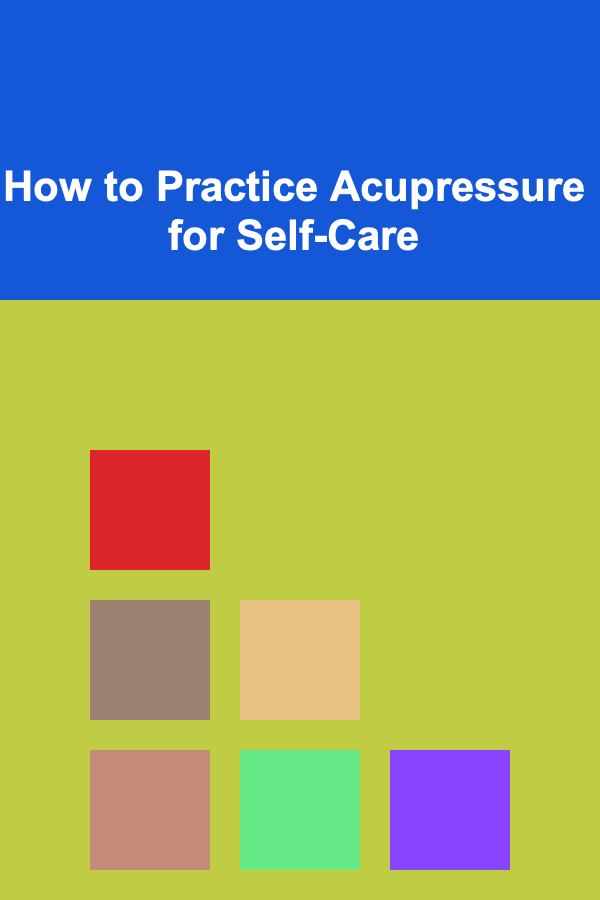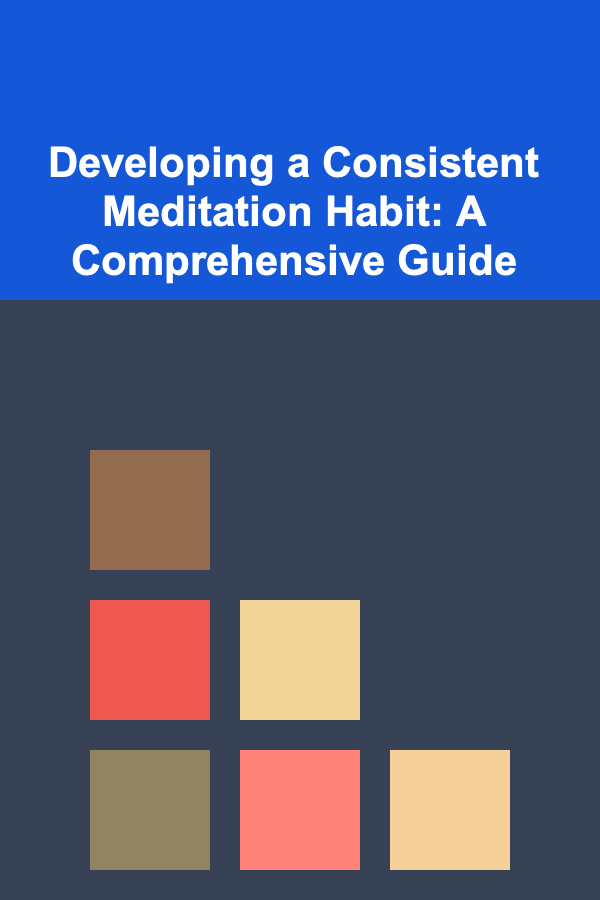
How to Practice Acupressure for Self-Care
ebook include PDF & Audio bundle (Micro Guide)
$12.99$7.99
Limited Time Offer! Order within the next:

Acupressure is an ancient healing technique rooted in Traditional Chinese Medicine (TCM) that has been practiced for thousands of years. It involves applying pressure to specific points on the body, known as acupoints, to promote physical and emotional healing. Similar to acupuncture, acupressure is believed to stimulate the body's energy, or "Qi" (pronounced "chee"), and help restore balance and improve overall health.
In this article, we'll explore the practice of acupressure and how you can use it for self-care. We'll delve into the history and theory behind acupressure, the various techniques you can use, and some key acupressure points that are beneficial for common ailments. Additionally, we'll discuss how to incorporate acupressure into your daily self-care routine for optimal health and well-being.
Understanding Acupressure: The Basics
The Theory Behind Acupressure
At the core of acupressure is the belief that energy, or Qi, flows through specific pathways in the body called meridians. These meridians are essentially channels through which the life force flows, and when they become blocked or unbalanced, illness or discomfort may arise. Acupressure is based on the principle that by applying pressure to certain points along these meridians, you can restore the flow of Qi and help the body heal.
There are over 350 acupressure points on the body, each linked to a specific organ or system. By stimulating these points, acupressure is said to help regulate the body's functions, relieve pain, reduce stress, and support overall health.
How Acupressure Works
Acupressure works by stimulating pressure points to affect the body's nervous system. This can help to release muscle tension, improve blood circulation, and promote the production of endorphins, which are natural pain relievers. The pressure applied to acupoints is thought to help relax the body, reduce pain, and promote a sense of well-being.
Unlike acupuncture, which uses needles to stimulate acupoints, acupressure uses the hands, fingers, or even tools like acupressure mats to apply pressure. The pressure used in acupressure is gentle yet firm enough to stimulate the body's natural healing responses.
The Benefits of Acupressure for Self-Care
Practicing acupressure as part of your self-care routine can provide a wide range of physical and emotional benefits. Here are just a few of the many benefits you can experience from acupressure:
1. Stress Relief
One of the most common reasons people turn to acupressure is to reduce stress. Many acupressure points, such as the ones located on the hands, wrists, and shoulders, are known to promote relaxation and help release accumulated tension. Regular acupressure sessions can help balance the nervous system, reduce anxiety, and foster a sense of calm.
2. Pain Relief
Acupressure can be highly effective in relieving both acute and chronic pain. By targeting specific pressure points associated with pain in the body, you can alleviate discomfort caused by headaches, back pain, muscle tension, and even menstrual cramps. For instance, acupressure points like the "Hegu" point, located on the hand, can help relieve pain and tension in the head, neck, and shoulders.
3. Improved Sleep Quality
Acupressure has been shown to promote deeper, more restful sleep by helping to regulate the body's circadian rhythm and balance hormones. Certain acupressure points are known to calm the mind and prepare the body for sleep, making it a great natural remedy for insomnia.
4. Enhanced Digestion
Acupressure can also support digestive health by stimulating points related to the stomach, intestines, and other digestive organs. Applying pressure to these points can promote better digestion, alleviate bloating and constipation, and help manage symptoms of nausea and indigestion.
5. Emotional Balance
Acupressure can help to regulate emotional health by balancing the energy within the body. It has been found to reduce symptoms of depression, anxiety, and emotional stress. Certain points on the body can help release stored emotional tension and improve overall emotional well-being.
Techniques for Practicing Acupressure
To practice acupressure effectively, it's important to understand the different techniques for applying pressure. Here are some common methods used in acupressure:
1. Finger Pressure
The most common method of acupressure is using your fingers to apply pressure to specific points on the body. Use the pads of your fingers (not the tips) to apply firm, steady pressure. You can use your thumb, index finger, or middle finger, depending on the size and location of the acupoint.
2. Palm Pressure
If you need to apply pressure to a larger area or deeper point, you can use the palm of your hand. This method is particularly effective for points located on the back, shoulders, and abdomen.
3. Knuckle Pressure
For points that require more pressure, such as those on the back of the body, using the knuckles can be a great way to apply deep, targeted pressure.
4. Circular Motion
For some acupressure points, it's helpful to use a gentle circular motion to massage the area. This can help to stimulate the flow of Qi and relax the muscles.
5. Holding
In some cases, you may simply need to hold the pressure point for a certain amount of time. Apply pressure and hold it for 30 seconds to 2 minutes, allowing the energy to flow and the body to respond.
6. Acupressure Tools
If you find it difficult to apply pressure with your hands, you can also use acupressure tools. These tools are designed to target specific points and provide consistent pressure. Common tools include acupressure mats, which have small spikes that apply pressure to the back, and acupressure balls, which can be rolled over specific points on the body.
Key Acupressure Points for Self-Care
Now that you understand the basics of acupressure techniques, let's explore some of the most effective acupressure points for self-care. These points are beneficial for common ailments and can easily be incorporated into your daily routine.
1. Hegu (LI4) -- For Pain Relief and Stress Reduction
The Hegu point, located between the thumb and index finger, is one of the most well-known acupressure points for pain relief. Applying pressure to this point can help alleviate headaches, toothaches, and neck pain. It is also used to reduce stress and anxiety.
To locate Hegu, place your thumb and index finger together and press down on the webbing between them. Apply firm pressure for 30 seconds to 1 minute.
2. Shenmen (HT7) -- For Relaxation and Sleep
Shenmen, located on the wrist, is known as the "Heart Gate" and is commonly used for relaxation and sleep. It can help calm the mind, reduce anxiety, and improve the quality of sleep.
To find Shenmen, place your thumb on the inside of your wrist, just below the base of the palm. You should feel a small depression in the wrist crease. Apply gentle pressure for 1-2 minutes.
3. Stomach 36 (ST36) -- For Digestion and Energy
The Stomach 36 point is located about 3 inches below the knee, along the outer edge of the shinbone. It is one of the most important points for promoting digestion and boosting energy levels. Applying pressure to this point can help alleviate bloating, constipation, and other digestive issues.
To locate ST36, measure about 3 inches below your kneecap, and apply pressure to the area on the outside of your leg. Hold for 1-2 minutes.
4. Liver 3 (LV3) -- For Emotional Balance
Liver 3 is located on the top of the foot, in the space between the first and second toes. This point is known for its ability to calm the mind, relieve stress, and promote emotional balance. It can also be helpful for headaches and menstrual cramps.
To locate LV3, press the point between your first and second toes, about 1-2 inches from the webbing. Apply steady pressure for 1-2 minutes.
5. Pericardium 6 (PC6) -- For Nausea and Anxiety
Pericardium 6 is located on the inside of the forearm, about 2 inches above the wrist crease. It is often used for relieving nausea, motion sickness, and anxiety.
To locate PC6, place three fingers on the inside of your wrist, just above the crease. Apply gentle pressure to the area between the two tendons. Hold for 1-2 minutes.
Incorporating Acupressure into Your Daily Self-Care Routine
Acupressure can be a powerful tool for self-care, but like any wellness practice, consistency is key. To incorporate acupressure into your daily routine, here are some tips:
- Start with Simple Points: Begin with easy-to-reach points, such as Hegu (LI4) and Shenmen (HT7), and gradually incorporate other points as you become more comfortable with the practice.
- Make It a Daily Habit: Set aside 10-15 minutes each day for an acupressure session. This can be done in the morning to start your day with energy or at night to relax before bed.
- Use Acupressure for Specific Ailments: If you're experiencing a particular issue, such as headaches, digestive discomfort, or anxiety, focus on the acupressure points that target those areas.
- Pair with Other Self-Care Practices: Acupressure can be enhanced when paired with other self-care practices, such as meditation, yoga, or deep breathing exercises.
Conclusion
Acupressure is a simple, effective, and natural method for improving both physical and emotional well-being. By incorporating acupressure into your self-care routine, you can alleviate stress, relieve pain, enhance digestion, improve sleep, and support overall health. With regular practice and attention to key acupressure points, you can take charge of your health and enjoy the many benefits this ancient technique has to offer. Whether you're looking for relaxation, pain relief, or emotional balance, acupressure can be a powerful tool for your self-care journey.

How to Adjust Your Home Budget for Unexpected Expenses
Read More
How to Make the Most of Your Small Space with Hidden Storage
Read More
How to Organize Your Home Office Supplies
Read More
Understanding the Role of Community in Gaming
Read More
Developing a Consistent Meditation Habit: A Comprehensive Guide
Read More
How to Develop Individual Player Skills: A Basketball Coach's Guide
Read MoreOther Products

How to Adjust Your Home Budget for Unexpected Expenses
Read More
How to Make the Most of Your Small Space with Hidden Storage
Read More
How to Organize Your Home Office Supplies
Read More
Understanding the Role of Community in Gaming
Read More
Developing a Consistent Meditation Habit: A Comprehensive Guide
Read More